
Tag Archives: modernart
WOW! – Work of the Week – James Rosenquist – Sky Hole, from Welcome to the Water Planet

WOW! – Work of the Week – Roberto Matta – Hours of the Day

8am

8pm

10pm
|
WOW! – Work of the Week – John Baldessari – Money with Space Between


WOW! – Work of the Week – Roy Lichtenstein – Forms in Space
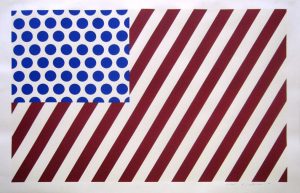
WOW! – Work of the Week – Sol LeWitt – Distorted Cubes #2
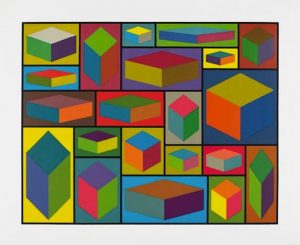
WOW! – Work of the Week – Alex Katz – Laura 1
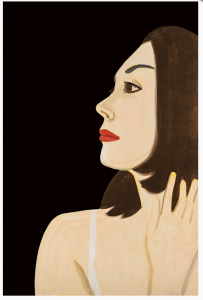
| Alex Katz Laura 1 2017 Archival pigment inks on Crane Museo Max 365 gsm fine art paper 46 x 30 1/2 in. Edition of 100 Pencil signed and numbered |
About the work:
Portraits are one of the great subjects of Alex Katz’s oeuvre. With his signature approach and style, he transforms his circle of family, friends and New York society figures into unforgettable icons. His works are defined by their flatness of color and form, their economy of line, and cool yet seductive emotional detachment.
Katz is the ultimate master of the flat style. His works may appear simple, but rather they are complex studies of color and shading. A student of color theory, he expertly captures depth and dimension with contrasting and complimentary hues like no other artist.
This week’s Work of the Week! WOW! is one of Katz’s most recent portraits, Laura 1. This work is the portrait of Laura Halzack, prima ballerina of the Paul Taylor Dance Company based in New York City. Alex Katz met Laura through Paul Taylor with whom he has collaborated with on over a dozen set and costume designs since 1960.
Laura, as many of Katz’s portrait subjects is presented without context. In the compressed visual plane, she is placed against a background of a single dark hue, which contrasts with the delicate peach tone of her skin. No additional narrative is provided other than her first name. This lack of narrative heightens the enigmatic qualities of the dancer, and allows Laura to exist in and of herself.
Influenced by film, television and billboard advertising, the composition of Laura 1 is like a cinematic close-up. The cropped view of the dancer’s profile is perfectly balanced with the black background. The work is cropped in a way that it seems Katz has captured a sincere, temporal moment, which he indeed has, given the ephemeral nature of dance.
Katz’s distinction as an artist lies in the fascinating reductive, flat style. His mastery of color and minimalism is timeless. His portraits, also have a distinctive quality in that he always represents the society of which he is a part of and, as a whole, can almost be experienced as a family photo album.
WOW! – Work of the Week – Jim Dine – Watercolored by Jim
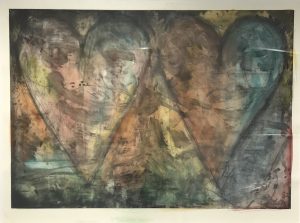
| Jim Dine Watercolored by Jim 2015 Watercolor and copperplate etching 42 x 56 1/2 in. Edition of 6 unique hand-painted pieces Pencil signed, dated, titled and numbered |
About the work:
During the early 1960s, with Pop Art in full swing, one of its earliest champions, Jim Dine, had already moved away from its ideas and was striking out on his own. Marked by a compulsive repetition of subject matter yet tempered with humanity and warmth, the oeuvre that the artist has produced over the last 60 years forms one of the most original bodies of work in 20th- and 21st-century art.
Among his iconic images, hearts are prominently featured. Dine has laid undisputed claim to the simple shape, suggesting boundless possibilities endowed with complex meaning. While repetition was a common motif in Pop Art, Dine employed it to a very different end. Pop was playing with art as mass culture while Dine was imposing a personal, lyrical individualism into his faceless forms. A self-described romantic artist, Dine has embraced the heart as a template through which he could explore relationships of color, texture, and composition. It is a subject of his work that is invested with rich personal significance.
This week’s Work of the Week! WOW! is Watercolored by Jim.
Dine painted his first heart in 1966, developed as a form of self-portraiture while he went through psychoanalytical treatment. The heart-themed works are defined by introspection and emotional vigor, continuously reinvented through the artist’s tactile brushwork, and inventive printmaking techniques. Dine uses the symbolism of the heart for its obvious connection to the strong emotions of love, but also for its values as a geometric framework within which dynamic color relationships and textures can be explored.
The powerful presence of the two hearts in Watercolored by Jim suggests human interaction, the smoky texture is combined with soft fields of watered-down color suggest a complex delicacy. Despite its lightness, it is strong work, as Dine’s expressionist energy is freed from the form. The colors vibrate against one another, fill and bleed beyond the hearts outlines in an organic blending into dense layers.
Dine has a distinct approach to printmaking, it provides him with an opportunity to focus his creative energy on small editions of works that are often experimental in technique and finished by hand. Watercolored by Jim is an edition of 6 unique hand-painted works with watercolor (hence the title) in which only the black lines are printed through copperplate etching.
The work is a tour de force of Dine’s experimentation with innovative monotype and other printmaking techniques. The traditional etching techniques combined with hand-applied details result in this distinctive work that bridges printmaking and painting.
With this painterly work, Dine continues to reinvent the form. The artist’s assertive brushwork is heightened by a soft texture endowing one of his most iconic images with fresh and exciting energy.
WOW! – Work of the Week – Richard Anuszkiewicz – Temple of the Golden Red
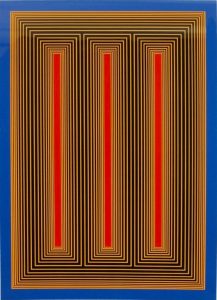
| Richard Anuszkiewicz Temple of the Golden Red 1985 Screenprint 32 x 24 in. Edition of 175 Pencil signed, dated and numbered |
About the work:
“I’m interested in making something romantic out of a very, very mechanistic geometry. Geometry and color represent to me an idealized, classical place that’s very clear and very pure.“ Richard Anuszkiewicz
Richard Anuszkiewicz was a central figure, along with Briget Riley and Victor Vasarely, in the Op Art movement. As a graduate student at Yale, he was mentored by the color theorist Josef Albers who would steer him on a course toward pure abstraction, grounded in the power of color. Most of his work trends away from personal emotion and drama, seeking rather visual investigations of formal structural and color effects. He made extensive use of ‘simultaneous contrast’ – where two colors, side by side, interact with one another to change our perception of them accordingly.
Among his most famed suites is the Temple Series; mesmerizing works, saturated with vibrant color arranged in geometric abstract compositions. The Temple Series originated after a 1981 trip to Egypt. He was inspired by the geometries of sacred temples,specifically those located in the Valley of the Kings. As is characteristic of most of his works, there are no specific references to individual structures, instead he uses the geometric framework as a space of color experimentation. The works in the series have been interpreted as illustrating visionary architect Buckminster Fuller’s notion of ‘Tensegrity’ – the balance between the forces of tension and integrity inherent in a physical structure.
This week’s Work of the Week! WOW! from the Temple Series is Temple of the Golden Red.
Temple of the Golden Red is a quintessential example of Anuszkiewicz’s mature style. Incorporating a repeating pattern of vertically oriented rectangles surrounded by concentric lines of startlingly different color. It contains three central rectangles of saturated crimson surrounded by lines of alternating but as equally saturated yellow and black. Symmetry is essential in Anuszkiewicz’s work, and by juxtaposing opposite colors of equal saturation, he accomplishes a visual fluctuation between figure and ground, creating a vibrating or pulsating sensation in the eye. The result is a release of energy, a transformation of color into motion. Like all great work that depends in large measure on color for its impact, the intensity lays in the way the eye and brain interpret visual information.
As with most artworks, Anuszkiewicz’s work is much more powerful in person. From Temple of the Golden Red emanates a profound luminosity, appearing as if lit from an inner source. New York Times art critic Holland Cotter described Anuszkiewicz’s works by stating, “The drama – and that feels like the right word – is in the subtle chemistry of complementary colors, which makes the geometry glow as if light were leaking out from behind it.” The artwork also packs a powerful monumentality, a result of its architectonic framing that gives the illusion of standing in front of a physical temple. Despite that the work is inspired from a trip to Egypt, the ‘fluting’ can seem to have more in common with classical ancient Greek columns.
Within the boundaries Anuszkiewicz set for himself—vertical bars of color surrounded by the pinstriped framework, the range of effects achieved is remarkable. The colors appear to blaze forth or recede into the distance and the choice of colors projects a mood, in this case, a jazzy up-tempo. Despite the restless optical power of the piece, it is thoroughly classical.
WOW! – Work of the Week – Andy Warhol – The Shadow

| Andy Warhol The Shadow, from Myths (FS II.267) 1981 Screenprint on Lenox Museum Board 38 x 38 in. Edition of 200 Pencil signed and numbered |
About the work:
As a keen observer of the emergence of America as the global superpower it is today, Andy Warhol captured deep American truths and fantasies. “Everybody has their own America, and then they have pieces of a fantasy America that they think is out there but they can’t see,” he once observed. Nowhere is this national fantasy clearer than in Warhol’s Myths Series of 1981.
The suite, composed of 10 iconic representations of recognizable figures of American film, history and culture encompass Warhol’s own life and the magic of 20th century American Pop Culture, or American Mythology. The term ‘Mythology’ (or ‘Myth’) often-times evokes the collected stories of the Ancient Greeks and Romans, however, Mythology is a feature of every culture. The collection of myths of any society defines its spirit and soul.
In the Myths Series, Warhol selected a range of 10 uniquely American personas, from Santa Claus to Uncle Sam, each artwork revealing facets of Warhol’s personality and desires. As a sick child, he was inspired by the duality of Clark Kent/Superman and famously wanted to be regarded as strong an american symbol as Mickey Mouse. Warhol so ardently wanted to be a part of American Mythology that he used his own self-portrait to take on the role of one of the characters in the Myths suite. Overtly self-referential, the artist placed himself among his idols.
This week’s Work of the Week! WOW! is The Shadow, from Myths, in which Andy Warhol used his own face to personify a fictional American icon.
While many of the referenced characters of the suite require no introduction, today ‘The Shadow’ is a more niche symbol of American Pop Culture. ‘The Shadow’ was a fictional pulp-novel character of the 1930’s, a crime-fighting hero of Warhol’s childhood. He wore a wide-brimmed black hat and a black, crimson-lined cloak with an upturned collar over a standard black business suit.
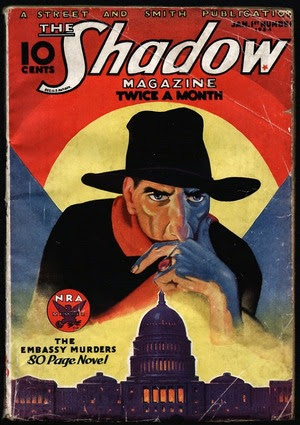 The popular series was also adapted into a Radio Show and a comic strip during Warhol’s lifetime.
The popular series was also adapted into a Radio Show and a comic strip during Warhol’s lifetime.
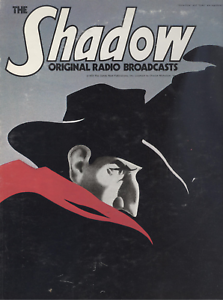 |
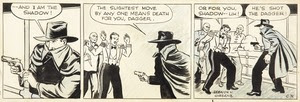 |
The portrait is based on a photograph of Warhol as the fictional character and although he doesn’t wear The Shadow’s black cloak or broad-rimmed hat, the crimson lighting illuminating Warhol’s face, which references the red lining of The Shadow’s cloak, causes a strong shadow to be cast of his profile in the background. While peering at the viewer, Andy Warhol crafts a personification of himself masquerading as a hero.
Andy Warhol exhibited an unerring sense for the powerful motifs of his time – contemporary images that capture the modern imagination as completely as the gods and goddesses of ancient mythology once did. The images presented in Myths are nostalgic representations of America, each theatrically reflecting American fantasies, hopes, fears and dreams. Warhol gives these already established icons his signature pop-style treatment, inserting his own image into the narrative of pop culture.
The Shadow from Myths is a screenprint on Lenox Museum board with Diamond Dust covering the full sheet. The Diamond Dust, heavily applied, adds a luster to the work, but also lends to its mysteriousness, thus accentuating The Shadow. It its a very impressive work.
